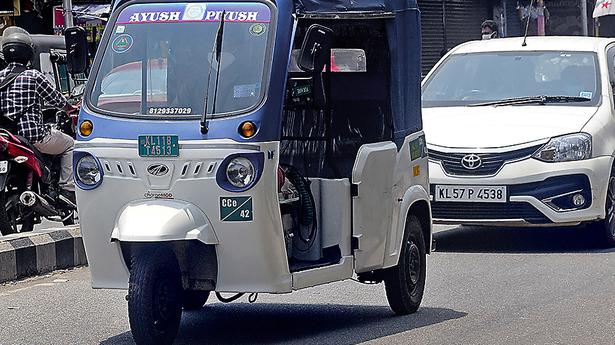
Explained | Why are electric vehicles catching fire?
The Hindu
Is the battery causing the problem? What are the safety measures that need to be followed to prevent explosions?
The story so far: The Union Government has constituted an expert panel to probe the recent series of battery explosions in electric vehicles (EVs). Manufacturers like Okinawa and Pure EV have recalled some batches of electric scooters following fire incidents involving the vehicles. Last Wednesday, an 80-year-old man died at his home in Telangana’s Nizamabad district after the battery of an electric scooter exploded while being charged. After the enquiry, the Ministry of Road Transport intends to issue guidelines for EVs, including tests for compliance with safety norms.
The growing concern over climate change has led to global efforts to electrify the transportation sector. In parallel, cost of Li-ion (Lithium-ion) battery technology has decreased by a staggering order of magnitude in the last decade. The convergence of these two factors has resulted in a unique time in our history where we are at the cusp of a dramatic transition in the transportation sector, with electric vehicles poised to replace petrol vehicles.
The world has taken note of this moment with governments providing incentives to usher in the transition and private industry ramping up plans for capturing the market. There is a worldwide race emerging, with vehicle companies, battery manufacturers, and material suppliers vying with each other for market share. However, Li-ion batteries are complex devices requiring a level of sophistication that can takes years to perfect. Hurrying the development of this complex technology without careful safeguards can lead to increasing safety incidents, as evidenced recently on Indian roads.
Every Li-ion battery consists of three active components: the anode, typically graphite; the cathode, typically based on a nickel, cobalt, and manganese-based oxide; and an electrolyte, typically a salt of lithium in an inorganic solvent. Battery manufacturing is a complex operation involving forming sheets of the anode and cathode and assembling them into a sandwich structure held apart by a thin separator.
Separators, about 15 microns in thickness — about a fifth of the thickness of the human hair — perform the critical function of preventing the anode and cathode from shorting. Accidental shorting of the electrodes is a known cause of fires in Li-ion cells. It is important that the various layers are assembled with high precision with tight tolerances maintained throughout the manufacturing process. Safety features, such as thermal switches that turn off if the battery overheats, are added as the sandwich is packaged into a battery cell.
Battery cells are assembled into modules and then further assembled into packs. Li-ion batteries require tight control on the state of charge and the temperature of operation to enhance safety and increase usable life, achieved by adding multiple sensors. Packs are designed to ensure uniform temperature profile with minimal thermal variation during operation. Ensuring robust detection, coupled with battery management systems that interpret the data and change operation based on changes to the batteries state, remain critically important in enhancing battery performance.
Battery packs are integrated into the vehicle in unique formfactors depending on the design of the vehicle. The location of the battery should protect it from external penetration, ensure passenger safety while talking into consideration the overall weight distribution. Close interaction between vehicle manufacturers and battery manufacturers is essential so that the whole is greater than the sum of the parts.

The Union Budget unveiled on February 1, 2025, has come at a time of unprecedented global uncertainty and a flagging domestic economy. The real GDP growth is estimated at 6.4% for 2024-25 and between 6.3-6.8% for 2025-26, a far cry from >8 percent growth required annually to make India a developed nation by 2047. While much attention has been devoted to the demand stimulus through income tax cuts, not enough is said about the proposed reforms in urban development, tariff rationalisation, and regulatory simplification aimed at making Indian cities and corporates more competitive. Since the majority of economic activity is located in cities (urban areas account for ~55% of GDP) and produced by large corporates (~40% of the national output and 55% of India’s exports), the above-mentioned reforms have a pivotal role in improving India’s trend growth rate. Below we unpack each reform.












